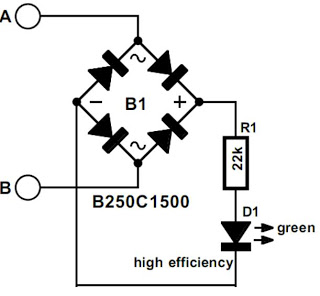
indicator circuit

The modem off indicator is designed specifically for avid Internet users. The circuit for this indicator is remarkably simple, and its simplicity may lead to significant cost savings by providing a clear visual indication of whether the telephone line is free after modem usage. This is particularly useful in preventing high telephone charges that may arise if the modem remains active unintentionally. The circuit operates based on the principle that the telephone line exhibits a potential of approximately 40 V when not in use, which drops significantly during a phone call. By connecting the circuit to the telephone terminals labeled a and b, a green LED lights up to indicate that the line is not busy. The inclusion of a bridge rectifier in the circuit ensures that the polarity of the line voltage does not affect operation, eliminating the need for polarity protection for the LED. To prevent unnecessary loading of the telephone line, a high-efficiency LED is utilized, which operates at a current as low as 2 mA, the current supplied through resistor R1.
The modem off indicator circuit is a straightforward yet effective solution for monitoring the status of a telephone line in relation to modem activity. The primary components of the circuit include a green LED, a bridge rectifier, and a current-limiting resistor (R1).
The bridge rectifier is crucial as it converts the alternating current (AC) from the telephone line into direct current (DC), allowing the LED to function regardless of the line's polarity. This feature simplifies the design and enhances reliability, as it removes the need for additional components to protect against reverse polarity.
The use of a high-efficiency LED is particularly advantageous in this application. By requiring only 2 mA for illumination, the circuit minimizes the load on the telephone line, ensuring that it does not interfere with normal telephone operations. Resistor R1 is selected to limit the current flowing through the LED to this optimal level, thus ensuring longevity and consistent performance of the indicator.
When the telephone line is idle, the voltage present allows the LED to light up, providing a clear visual cue to the user. Conversely, when a call is initiated, the voltage drops, extinguishing the LED and indicating that the line is busy. This functionality is essential for users who rely on their modem for Internet access, as it prevents unnecessary charges that could accumulate if the modem remains active while the line is in use.
Overall, the modem off indicator circuit is an elegant solution that combines simplicity with functionality, making it an invaluable tool for managing telephone line usage effectively. Its design ensures minimal impact on the telephone line while providing crucial information to the user.The modem off indicator is intended especially for serious Internet surfers. It will be seen that the circuit of the indicator cannot be much simpler, or there might be nothing left. In spite of its simplicity, it may prove to be a cost-saving device, since it shows at a glance whether the telephone line is free again after the modem has been used
. This obviates high telephone charges in case for some reason the modem continues to operate. The circuit depends on the fact that there is a potential of about 40 V on the telephone line when it is not busy. This voltage drops sharply when a telephone call is being made. If, therefore, the circuit is linked to telephone terminals a and b, the lighting of the green LED shows that the line is not busy in error.
The bridge rectifier ensures that the polarity of the line voltage is of no consequence. This has the additional benefit that polarity protection for the LED is not necessary. To make sure that the telephone line is not loaded unnecessarily, the LED is a high efficiency type. This type lights at a current as low as 2 mA, and this is, therefore the current arranged through it by resistor R1. 🔗 External reference
The modem off indicator circuit is a straightforward yet effective solution for monitoring the status of a telephone line in relation to modem activity. The primary components of the circuit include a green LED, a bridge rectifier, and a current-limiting resistor (R1).
The bridge rectifier is crucial as it converts the alternating current (AC) from the telephone line into direct current (DC), allowing the LED to function regardless of the line's polarity. This feature simplifies the design and enhances reliability, as it removes the need for additional components to protect against reverse polarity.
The use of a high-efficiency LED is particularly advantageous in this application. By requiring only 2 mA for illumination, the circuit minimizes the load on the telephone line, ensuring that it does not interfere with normal telephone operations. Resistor R1 is selected to limit the current flowing through the LED to this optimal level, thus ensuring longevity and consistent performance of the indicator.
When the telephone line is idle, the voltage present allows the LED to light up, providing a clear visual cue to the user. Conversely, when a call is initiated, the voltage drops, extinguishing the LED and indicating that the line is busy. This functionality is essential for users who rely on their modem for Internet access, as it prevents unnecessary charges that could accumulate if the modem remains active while the line is in use.
Overall, the modem off indicator circuit is an elegant solution that combines simplicity with functionality, making it an invaluable tool for managing telephone line usage effectively. Its design ensures minimal impact on the telephone line while providing crucial information to the user.The modem off indicator is intended especially for serious Internet surfers. It will be seen that the circuit of the indicator cannot be much simpler, or there might be nothing left. In spite of its simplicity, it may prove to be a cost-saving device, since it shows at a glance whether the telephone line is free again after the modem has been used
. This obviates high telephone charges in case for some reason the modem continues to operate. The circuit depends on the fact that there is a potential of about 40 V on the telephone line when it is not busy. This voltage drops sharply when a telephone call is being made. If, therefore, the circuit is linked to telephone terminals a and b, the lighting of the green LED shows that the line is not busy in error.
The bridge rectifier ensures that the polarity of the line voltage is of no consequence. This has the additional benefit that polarity protection for the LED is not necessary. To make sure that the telephone line is not loaded unnecessarily, the LED is a high efficiency type. This type lights at a current as low as 2 mA, and this is, therefore the current arranged through it by resistor R1. 🔗 External reference





